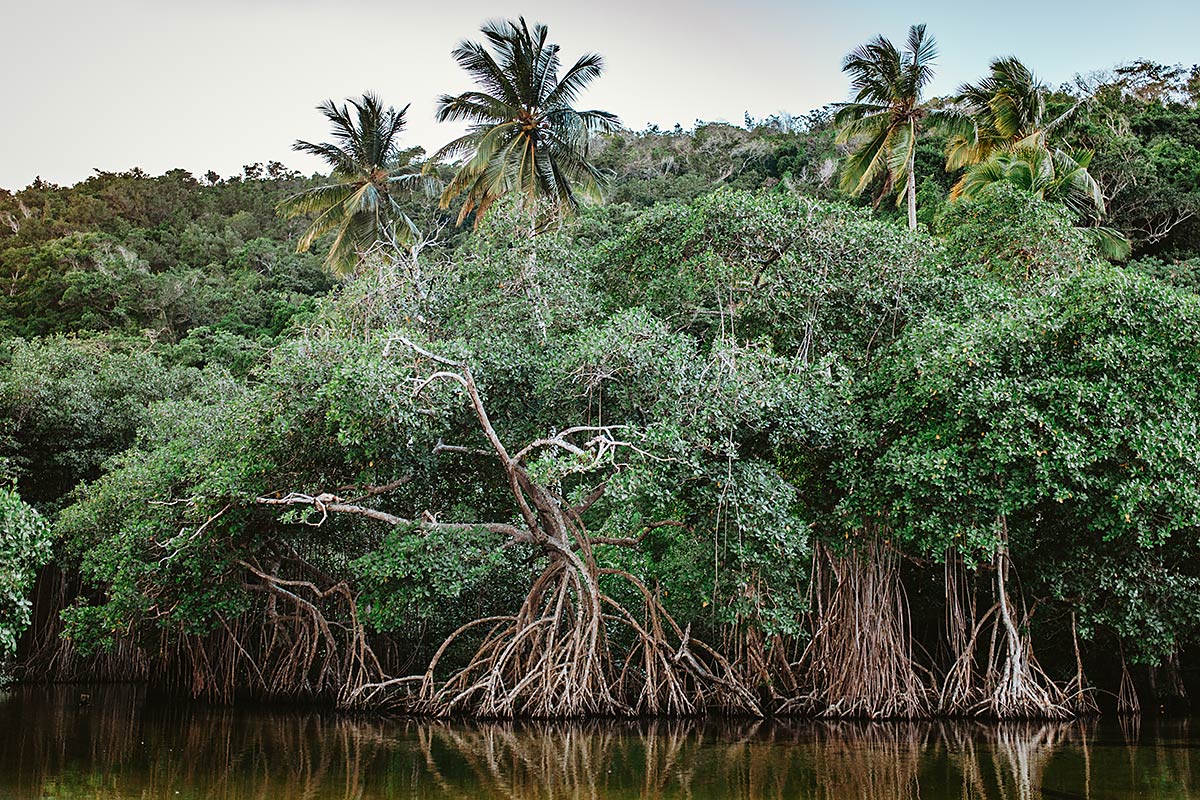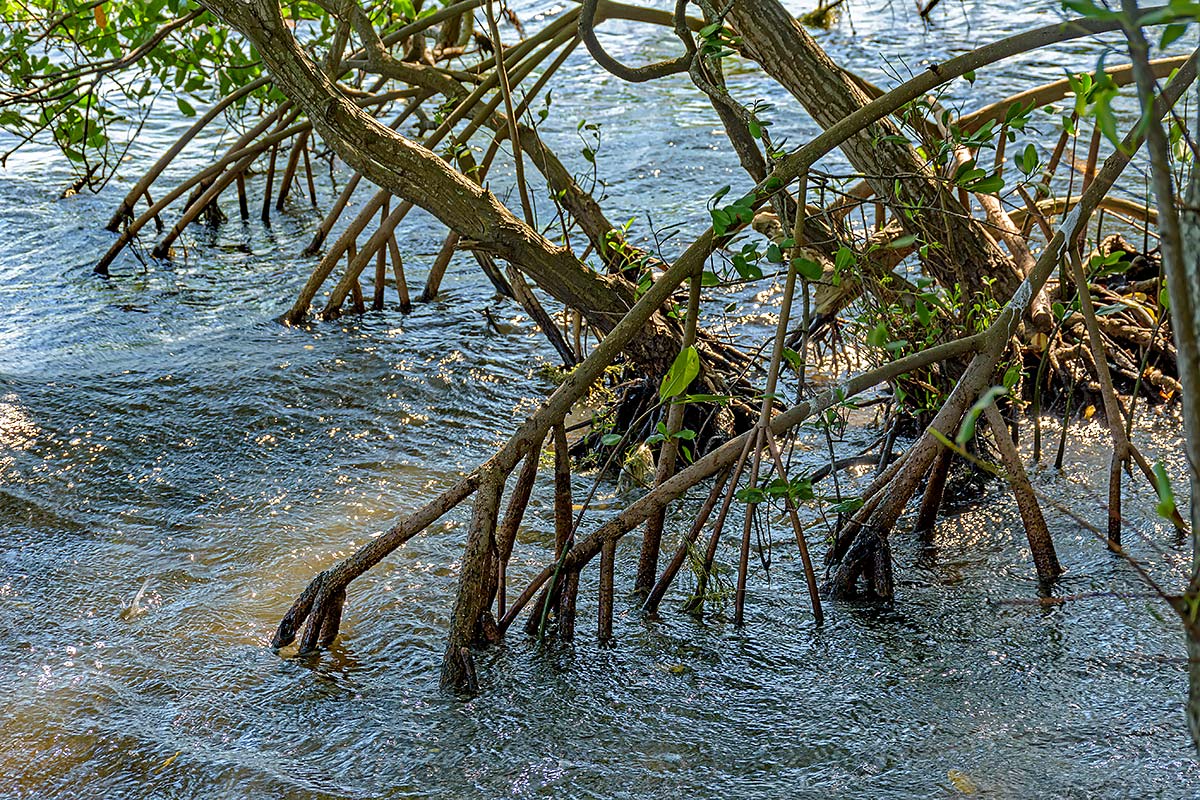What do “lungs of the earth” remind you of? We usually think of the Amazon forest, the largest forest of the earth. However, there is another “lung of the earth.” It is mangrove forests which are essential for the coastal ecosystems in tropical regions.
Mangrove Ecology

There are about 80 different species of mangrove trees. They grow at tropical and subtropical coastlines or in brackish water zone (where the sea and river meet). Oddly enough, mangroves are land plants that bloom flowers and bear fruit, but they live along shores, rivers, and estuaries. They contain a complex salt filtration system and a special root system to cope with saltwater immersion and wave action. It has a unique shape with its aerial roots that rise above the ground to withstand low oxygen and anaerobic conditions of waterlogged mud.
The complex mangrove root system is competent in binding sediments from rivers and shores. Thanks to this root system, it prevents coastal erosion caused by waves and protects coastal ecosystems and communities from powerful tropical storms. At the shallow place, mangroves grow even 200–300 m [0.1–0.2 mile] away from the shore, alleviating the impact of the tsunami. It also filters pollutants from the water, which improves the quality of water flowing from rivers and streams.
Mangrove communities have a decisive influence on coastal ecosystems in various tropical regions, and the ecosystems formed by mangrove forests occupy 60–75% of the coastline in tropical regions on the earth. In mangrove communities, tropical fish, coral reefs, and even sharks spawn or give birth, and the tree roots provide habitats to their young to live in between the roots. Since many species of fish grow in the mangroves, wildlife species such as seabirds and owls that feed on them flock together, and it becomes a nest for many endangered species, including animals and plants. Thanks to the mangrove forests that serve as nursery territories for many fish species, they increase fish catch dramatically, which greatly contributes to the economy of the local communities.
An Important Role in Combating Climate Change

Furthermore, mangroves are an effective carbon sink that captures massive amount of carbon dioxide emissions and traps them in their soil, leaves, branches, and roots. Their carbon storage capacity is up to five times better than that of land forests. Mangrove forests trap carbon dioxide and other greenhouse gases from the atmosphere and store them in the soil for millennia. One hectare of mangrove communities can store 3,754 tons of carbon per year. This is equivalent to removing carbon dioxide emitted by more than 2,650 cars a year. The buried carbon is known as “blue carbon” because it is stored underwater in coastal ecosystems like mangrove forests, seagrass beds, and salt marshes. As global warming has become one of the major challenges of our time and it is discovered that the blue carbon ecosystems absorb up to fifty times faster than terrestrial ecosystems, it is drawing much attention. In fact, the Intergovernmental Panel on Climate Change [IPCC] officially recognized blue carbon ecosystems as a means to reduce greenhouse gases in its Special Report on the Ocean and Cryosphere in a Changing Climate released in 2019.
Mangroves Are Disappearing

Although mangroves give great influence to the coastal ecosystem, people have cut down a large number of mangrove forests in the last few decades, because their roots which stand out from the ground does not look nice and they emit a large amount of bad adore as numerous species live inside. Scientists estimate that at least one third of mangrove forests has been lost during the last few decades.
Without mangroves, people would eventually suffer. It is a dismal scenario that includes coasts with barren and unproductive shores, collapsed fisheries, turbid and polluted water, loss of animals and plants, climate disasters, and sea level rise. Now these losses are felt most intensely by the communities that have removed or degraded their mangroves, eventually they affect all of us through reduced food security, enhanced migration, and increased potential for conflict.
From the 1980s to the 2000s, governments wiped out large mangrove forests and constructed shrimp farms, landfills, hotels, ports, etc. under the name of economic development, and they cut the trees to use them as a resource. Currently, water pollution and sea level rise due to global warming are causing the lose of mangroves all the more. This worsens global warming and accelerates climate change. The amount of carbon emitted by mangrove loss accounts for about one-fifth of the world’s total carbon emission through deforestation, causing economic loss of 6 to 42 billion dollars per year.
Globally, mangroves are at a high risk of being extinct. According to Global Mangrove Alliance, 67% of mangroves have been lost or degraded to date, and an additional 1% is lost annually. Overall, mangroves are disappearing 3 to 5 times faster than global forest losses. Without active policies that reverse the negative trend and preserve mangrove forests, mangrove forests may disappear in some areas. This will result in enormous ecological and economic loss in coastal areas.
International Day for the Conservation of the Mangrove Ecosystem

UNESCO has designated July 26 as the “International Day for the Conservation of the Mangrove Ecosystem” since 2015. It aims to raise awareness of the importance of mangrove ecosystems as “a unique, special and vulnerable ecosystem,” and to promote solutions for the sustainable management, conservation, and use of mangrove ecosystems.
Mangrove forests occupy less than 1% of all tropical forests worldwide, and less than 0.4% of the total global forest, but they are very important in global environment because it has a significant impact on food stability, living organisms, forest products, sustainable fisheries, coastline protection, mitigation of climate change and severe weather changes. Therefore, UNESCO is managing 86 mangrove-related sites by incorporating them into the World Network of Biosphere Reserves [WNBR].
“The importance of mangrove ecosystems is all too clear. Yet it is estimated that some countries lost more than 40% of their mangroves between 1980 and 2005, often due to coastal development . . . We are working to protect mangroves and to better support scientific research into these environments. However, we cannot do this alone. We also need you.”
Audrey Azoulay, Director-General of UNESCO(2021, on the occasion of the International Day for the Conservation of the Mangrove Ecosystem)